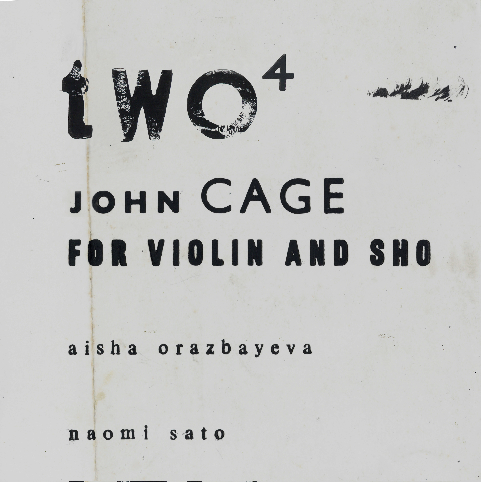 John Cage: Two4 Aisha Orazbayeva (violin), Naomi Sato (shō) (SN Variations)
John Cage: Two4 Aisha Orazbayeva (violin), Naomi Sato (shō) (SN Variations)
The shō is a Japanese wind instrument long associated with traditional court music. Looking like a bundle of sticks, its 17 pipes each plays a distinct pitch. Its sound is something else, the shō’s clusters of notes emerging and fading into silence along with the player’s breath. John Cage’s 1991 piece Two4 can be played by solo violin with piano or shō, their short-lived chords set against the violin’s ability to sustain individual notes for over a minute. Shō and violin blend well together in terms of sound; one of the things which gives this piece its strange power is the sense that the musicians are experiencing the passing of time at different rates, the shō moving through its chord patterns far more quickly than the violin’s long sustained notes. The brave violinist is expected to subdivide each semitone into six microtonal steps. Plus, each instrumentalist’s part is divided into separate movements: the violin having four and the shō three, the divisions apparently decided by using the I-Ching.
Listening to it is a pleasingly disconcerting experience; violinist Aisha Orazbayeva and shō player Naomi Sato tackling Cage’s sequences of "time brackets" with fierce concentration. This is one of those recordings it's difficult to switch off once you’ve hit the play button. Orazbayeva's supernatural ability to explore and sustain notes in the cracks between the conventional scale is a thing to marvel at, and Sato’s breathy, pungent tone-clusters weave their own magic. Don’t expect conventional musical development. Sit still, lower the lights and lose yourself in it. Beautifully recorded, with just the right amount of space between the players.
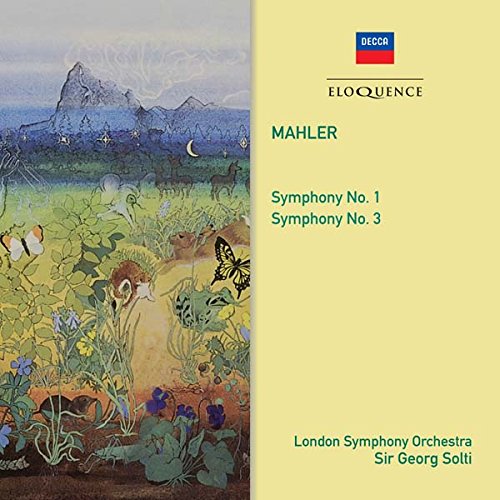 Mahler: Symphonies 1, 3 and 9 London Symphony Orchestra/Sir Georg Solti (Decca Eloquence)
Mahler: Symphonies 1, 3 and 9 London Symphony Orchestra/Sir Georg Solti (Decca Eloquence)
Sir Georg Solti’s Decca Mahler recordings were the way to go back in the LP era. His Chicago Symphony analogue recordings of symphonies 5-8 have stunning moments, despite the often fast speeds and occasionally aggressive brass. A complete CD cycle was put together in the 1980s, Solti rerecording the first four with the Chicago band. This meant that the earlier, London Symphony Orchestra accounts of symphonies 1, 2, 3 and 9 fell by the wayside. Now 1, 3 and 9 make a welcome reappearance on Decca Eloquence. These readings are, mostly, better than their more driven remakes, their freshness presumably owing much to the fact that this music wasn't standard repertoire back in the mid-1960s; the sense of excitement, of discovery, is palpable. And the orchestral playing has spectacular moments: the start of Symphony No 1’s finale is apocalyptic. Cheeky, piercing winds and fruity horns mean that Solti’s jauntily paced ländler is one to savour, and the symphony’s opening showcases the orchestra’s superb horns.
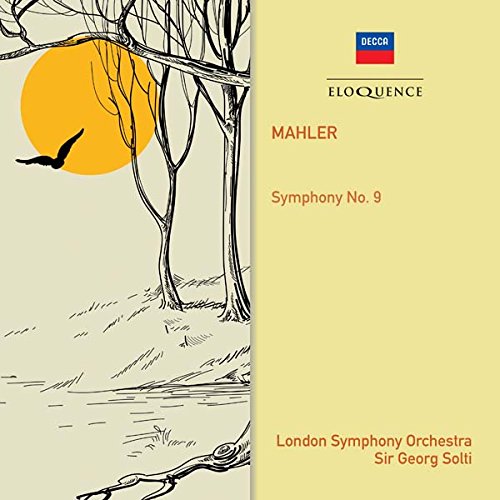 The same virtues are audible in this moving Mahler 9, taped in the Kingsway Hall three years later in 1967. Possibly one of the greatest ever recordings of the work, it's a mandatory purchase. Solti’s volatility is winning, and he coaxes playing of rare intensity from a fired-up LSO. The first movement's epic collapse really shocks, and the inner movements charm and startle by turns. A frantically paced Rondo: Burleske is especially thrilling; you wonder whether the players will manage to keep up. They do, just about, preparing us for an ecstatic slow finale. Barry Tuckwell’s horn solos are glorious throughout, and Solti paces the final minutes to perfection. If you're unfamiliar with this recording, dive in, and it's handily squeezed onto a single disc. Odd then that Symphony No 3, recorded in 1968, doesn't hit the same heights. Bits of it are excellent, especially the discursive opening movement. But the playing is a tad rougher, and Solti seems emotionally disengaged. Mezzo-soprano Helen Watts is impressive in the fourth movement, and I like Solti's flowing tempo in the finale, but this vast piece doesn't move as it should: here, the Chicago remake is the one to have.
The same virtues are audible in this moving Mahler 9, taped in the Kingsway Hall three years later in 1967. Possibly one of the greatest ever recordings of the work, it's a mandatory purchase. Solti’s volatility is winning, and he coaxes playing of rare intensity from a fired-up LSO. The first movement's epic collapse really shocks, and the inner movements charm and startle by turns. A frantically paced Rondo: Burleske is especially thrilling; you wonder whether the players will manage to keep up. They do, just about, preparing us for an ecstatic slow finale. Barry Tuckwell’s horn solos are glorious throughout, and Solti paces the final minutes to perfection. If you're unfamiliar with this recording, dive in, and it's handily squeezed onto a single disc. Odd then that Symphony No 3, recorded in 1968, doesn't hit the same heights. Bits of it are excellent, especially the discursive opening movement. But the playing is a tad rougher, and Solti seems emotionally disengaged. Mezzo-soprano Helen Watts is impressive in the fourth movement, and I like Solti's flowing tempo in the finale, but this vast piece doesn't move as it should: here, the Chicago remake is the one to have.
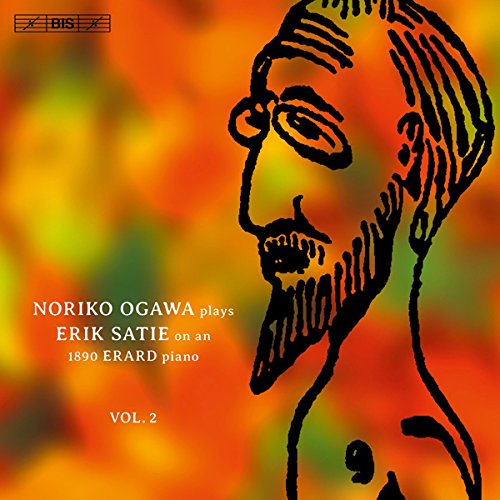 Noriko Ogawa plays Erik Satie on an 1890 Érard Piano – Vol. 2 (BIS)
Noriko Ogawa plays Erik Satie on an 1890 Érard Piano – Vol. 2 (BIS)
The track titles alone make this disc worth having. Who wouldn't want to hear a sequence of Flabby Preludes (for a dog), or its sequel, Genuine Flabby Preludes? The actual music is as peculiar as you’d expect, though the final “Avec camaraderie” of the first set is a winner, the changes in speed and mood familiar to anyone who's tried to walk an errant puppy. And the “Sévère réprimande” sounds just like the bollocking you’d give to a dog when it's destroyed your favourite shoes. The second volume of Noriko Ogawa’s Satie series is as good as the first, the music’s piquancy given added emphasis by her use of an Érard grand piano dating from 1890 – the instrument’s leaner, sharper sonority accentuating the strangeness of Satie's harmonies. Ogawa includes the composer’s early Three Sarabandes, written shortly before the ubiquitous Gymnopédies: elegant slow dances whose superficial good behaviour can't conceal some disarmingly peculiar chord progressions.
Ogawa gives us the complete set of Sports et divertissements, 21 short pieces describing a bewilderingly wide range of physical pastimes. They sound like beautifully judged soundtracks to silent films (“Les Courses”, “Le Tango” and “Le Feu d’artifice” especially effective). Stravinsky had originally been approached to compose the work, refusing when the fee was too low. Satie too was reluctant, complaining that the payment was too generous. Three sets of pieces composed for children are included – all delightful, each number using a restricted number of notes in pure C major. Plus an unsettling, uncharacteristic set of three Sonneries de la Rose+Croix, written for a mystical Catholic cult which Satie had joined, probably to help advance his career. Mystifying but wondrous, and Ogawa's clean, refined playing delights. Gorgeous recorded sound and good notes too.

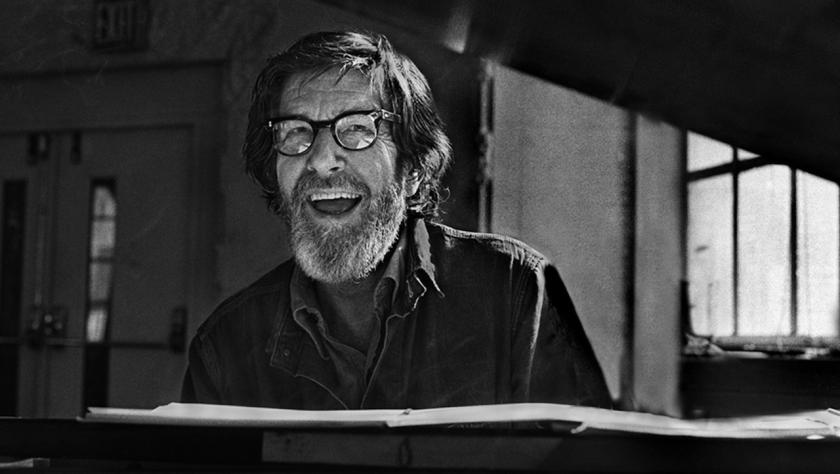












Add comment